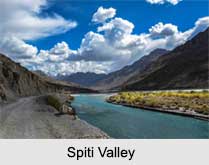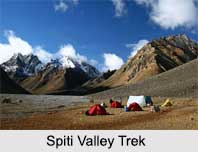 Spiti Valley is a desert mountain valley located high in the Middle Himalaya Mountains surrounded by high mountain ranges. The name "Spiti" means "The Middle Land", i.e. the land between Tibet and India. Spiti Valley possesses a distinctive Buddhist culture similar to that found in the nearby Tibet Autonomous Region and the Ladakh region of India. The valley and surrounding region is one of the least populated regions in India and is the gateway to the northernmost reaches of the nation.
Spiti Valley is a desert mountain valley located high in the Middle Himalaya Mountains surrounded by high mountain ranges. The name "Spiti" means "The Middle Land", i.e. the land between Tibet and India. Spiti Valley possesses a distinctive Buddhist culture similar to that found in the nearby Tibet Autonomous Region and the Ladakh region of India. The valley and surrounding region is one of the least populated regions in India and is the gateway to the northernmost reaches of the nation.
Location of Spiti Valley
The Spiti Valley is located far above the ground in the Himalaya Mountains in the north-eastern part of the Indian state of Himachal Pradesh. "Rohtang Pass", at 13,054 feet separates Lahul and Spiti from the Kullu Valley. Lahul and Spiti are disconnected from each other by the elevated "Kunzum Pass".
Climate of Spiti Valley
The solid Himalayan snow blocks make it nearly impossible for road transportation to pass through. Summer starts here from May to late September. As the weather warms up, snow gradually melts and gets cleared away to unlock the road to pass through the valley. Spiti Valley has only 250 days of sunshine in a year and winter in here is a harsh thing. Temperatures drop to -30 degree Celsius here.
Activities in Spiti Valley
Spiti is one of the best places for the adventure enthusiasts as it houses the best treks and ski areas in the world. Tourists may enjoy skiing, trekking and river-rafting activities in this area. Some of the popular trekking routes in this region include "Kaza-Langza-Hikim-Komic-Kaza", "Kaza-Ki-Kibber-Gete-Kaza", "Kaza-Losar-Kunzum La and Kaza-Tabo-Sumdo-Nako", "Grand Pin Parvati" etc. Routes are also perfect for trek which leads to Chandra valley.
 Spiti valley is also famous for the research and cultural centre for Buddhists. This valley includes other monasteries like "Key Monastery", "Dhankar Monastery" and "Tabo Monastery". These are one of the oldest monasteries in the world and a favourite of the Dalai Lama. It was the location of the spectacular scenery and cinematography in the Indian films like "Paap", "Highway" and "Milarepa". The Buddhist monastery in the valley served as the locus of the set and some of the monks appeared in the film. The "Pin Valley" of Spiti is home to the few surviving Buchen Lamas of the "Nyingmapa" sect of Buddhism. The small town of Manali was the beginning of an ancient trade route to Ladakh and, from there, over the "Karakoram Pass" on to Yarkand and Khotan in the Tarim Basin.
Spiti valley is also famous for the research and cultural centre for Buddhists. This valley includes other monasteries like "Key Monastery", "Dhankar Monastery" and "Tabo Monastery". These are one of the oldest monasteries in the world and a favourite of the Dalai Lama. It was the location of the spectacular scenery and cinematography in the Indian films like "Paap", "Highway" and "Milarepa". The Buddhist monastery in the valley served as the locus of the set and some of the monks appeared in the film. The "Pin Valley" of Spiti is home to the few surviving Buchen Lamas of the "Nyingmapa" sect of Buddhism. The small town of Manali was the beginning of an ancient trade route to Ladakh and, from there, over the "Karakoram Pass" on to Yarkand and Khotan in the Tarim Basin.
The "Chandratal Lake" and "Surajtal Lakes" are some of the most beautiful lakes in the world and are among the highest lakes in the world. The World"s highest village named the "Komic village" is located Spiti. It is known as little Tibet. There is a 500 year old self-mummified body of a Buddhist monk named "Sangha Tenzin" sheltered even today in Spiti"s "Gue" village. Spiti also has the World"s highest Post Office and the World"s highest Polling Station in the village of Hikkim. The headquarters of Spiti is at Kaza and is the only place in the entire valley that has a Fuel Station, a Cyber Cafe and a proper mobile network.
Eating options are limited at Spiti. Indian and Tibetan foods are offered in and around Kaza. There are some tribal restaurants in Spiti which specialize in Tibetan food and local dishes.
Visiting Information of Spiti Valley
Spiti valley is reachable all through the year via Kinnaur from Shimla route. Tourists from outside India need inner line permits to enter Spiti through Kinnaur. The distance from New Delhi to Spiti is around 430 kilometres. The nearest airport is Bhutar Airport (Kullu–Manali Airport) in Kullu. Shimla and Chandigarh are the closest railway stations.






